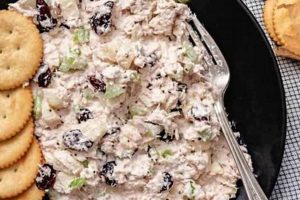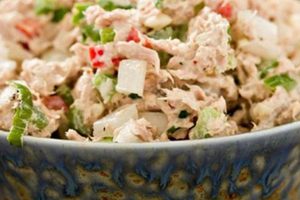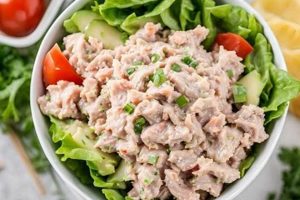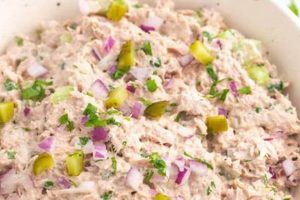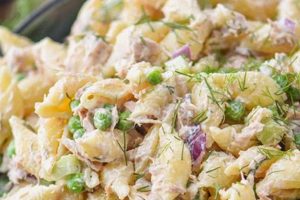A vibrant and flavorful dish, this variation on a classic typically features canned tuna combined with ingredients common in Mexican cuisine. These often include diced tomatoes, onions, cilantro, jalapeos, lime juice, and sometimes avocado, corn, or black beans. The mixture is frequently seasoned with cumin, chili powder, or other spices and served chilled. It can be enjoyed as a light lunch, appetizer, or filling for tacos, tostadas, or sandwiches.
This style of tuna salad offers a refreshing alternative to traditional mayonnaise-based versions. The citrus and spice components provide a bright, zesty flavor profile, while the addition of vegetables boosts both the nutritional value and textural complexity. This culinary fusion reflects the cultural exchange between Mexican and American cuisines and offers a delicious and accessible way to incorporate healthy fats and protein into one’s diet. Its adaptability allows for numerous ingredient variations and serving options, catering to diverse preferences.
The following sections will explore various aspects of preparing this dish, from ingredient selection and variations to serving suggestions and nutritional information. Recipes incorporating different levels of spice and complexity will be provided, catering to both novice and experienced cooks.
Tips for Crafting an Excellent Tuna Salad with Mexican Flavors
Optimizing ingredient selection and preparation techniques enhances the final dish, resulting in a more flavorful and enjoyable culinary experience. Attention to detail ensures the tuna salad reaches its full potential.
Tip 1: Quality Tuna Selection: Opting for high-quality canned tuna packed in water or olive oil contributes significantly to the overall flavor. Draining the tuna thoroughly prevents excess liquid from diluting the other ingredients.
Tip 2: Fresh Ingredients: Utilizing fresh produce like cilantro, onions, tomatoes, jalapeos, and lime juice elevates the flavor profile. Washing and properly chopping the ingredients ensures even distribution and optimal texture.
Tip 3: Spice Balancing: Carefully balancing spices like cumin, chili powder, and oregano prevents overpowering the delicate flavor of the tuna. Taste testing and adjusting seasonings throughout the preparation process allows for customization.
Tip 4: Lime Juice Freshness: Freshly squeezed lime juice offers a brighter, more vibrant flavor compared to bottled alternatives. Its acidity balances the richness of the tuna and other ingredients.
Tip 5: Avocado Incorporation: Adding ripe avocado introduces a creamy texture and healthy fats. Incorporating it closer to serving time prevents browning and maintains its appealing appearance.
Tip 6: Ingredient Variation: Experimenting with additional ingredients like corn, black beans, or diced bell peppers allows for personalized flavor profiles. These additions contribute textural variety and nutritional value.
Tip 7: Chilling Time: Allowing the salad to chill for at least 30 minutes before serving enhances flavor development and melding. This allows the ingredients to harmonize, resulting in a more cohesive taste experience.
By adhering to these guidelines, one can create a flavorful and well-balanced dish that showcases the vibrant essence of Mexican cuisine. The result is a tuna salad that is both refreshing and satisfying.
The following section will provide specific recipe examples incorporating these tips, demonstrating the versatility and deliciousness of this culinary creation.
1. Fresh Ingredients
The emphasis on fresh ingredients distinguishes a truly exceptional Mexican tuna salad. Fresh components contribute significantly to the vibrant flavors, crisp textures, and overall quality of the dish, elevating it beyond a simple combination of ingredients.
- Aromatic Herbs:
Fresh cilantro provides a bright, citrusy, and slightly peppery flavor that complements the other ingredients. Its aromatic presence enhances the overall sensory experience. Dried cilantro lacks the same intensity and can introduce an undesirable musty note. The inclusion of fresh cilantro exemplifies the importance of using high-quality, unprocessed ingredients in achieving an authentic flavor profile.
- Pungent Alliums:
Freshly diced white or red onion introduces a sharp, pungent element, which balances the richness of the tuna and the creaminess of the avocado (if used). The volatile compounds in fresh onions offer a complexity absent in pre-chopped or dried varieties. This sharpness is crucial for cutting through the richness of other ingredients.
- Ripe Tomatoes:
Juicy, ripe tomatoes contribute a burst of acidity and sweetness. Their moisture content also helps to bind the salad together. Using canned tomatoes often results in a watery consistency and a less vibrant flavor, impacting the overall appeal of the final product. Fresh tomatoes provide essential moisture and textural contrast.
- Vibrant Chiles:
Fresh jalapeos or serrano peppers offer a controlled level of heat, adding depth and complexity to the flavor profile. Their fresh, vegetal notes contrast with the richness of the tuna. While dried chiles can be used, they lack the nuanced flavors and fresh crunch of their fresh counterparts. The choice of chile directly influences the final heat level and complexity of the salad.
The careful selection and preparation of these fresh ingredients are essential for creating a Mexican tuna salad that bursts with authentic flavors and textures. Their combined impact elevates the dish beyond a simple combination of ingredients, resulting in a vibrant and satisfying culinary experience. The use of fresh ingredients is not merely a preference, but rather a cornerstone of achieving the authentic taste and texture characteristic of this dish.
2. Authentic Spices
Authentic spices form the foundation of a true Mexican tuna salad, differentiating it from other variations. These spices contribute not only distinct flavors but also represent the rich culinary heritage of Mexico. The careful selection and balance of these spices are crucial for achieving the desired complexity and depth of flavor. Cumin, chili powder, and oregano are frequently used, each playing a vital role in the overall flavor profile. Cumin offers a warm, earthy note, while chili powder contributes a smoky heat. Oregano provides a slightly pungent, herbal counterpoint. The combined effect of these spices creates a balanced, savory foundation for the other ingredients. For instance, omitting cumin would result in a flatter flavor profile, lacking the characteristic warmth associated with Mexican cuisine. Similarly, using a generic chili blend instead of a dedicated chili powder could introduce unwanted sweetness or other conflicting flavors. Understanding the role of each spice allows for informed adjustments and substitutions while maintaining the authenticity of the dish.
Beyond the core trio of cumin, chili powder, and oregano, other spices can enhance specific flavor profiles. Smoked paprika adds depth and complexity, while a pinch of cayenne pepper introduces a touch of heat. Garlic powder complements the other savory elements, while ground coriander seed offers a citrusy note. The choice of spices depends largely on the desired final flavor profile, but adhering to traditional Mexican flavor combinations ensures an authentic culinary experience. Using pre-mixed spice blends can simplify the process, but careful attention to their composition is necessary to avoid unwanted flavors or imbalances. Experimenting with different combinations of spices allows for personalized flavor profiles while respecting the foundational elements of Mexican cuisine.
The precise balance of these spices distinguishes an exceptional Mexican tuna salad from a mediocre one. Over-reliance on any single spice can lead to an unbalanced flavor profile. For example, too much chili powder can overwhelm the delicate flavor of the tuna, while an excess of cumin can make the salad taste overly earthy. Careful measurement and tasting throughout the preparation process are essential for achieving the desired balance. This careful consideration of spice selection and balance directly impacts the final quality and authenticity of the dish, highlighting the significant role spices play in defining the character of Mexican tuna salad.
3. Quality Tuna
Tuna quality significantly impacts the overall flavor and enjoyment of a Mexican tuna salad. Selecting the right tuna is crucial for achieving the desired taste and texture. Subpar tuna can detract from the other fresh ingredients, compromising the final dish. This section explores key facets of tuna quality relevant to this recipe.
- Tuna Species:
Different tuna species offer varying flavor profiles and textures. Albacore tuna, known for its mild flavor and firm texture, is a popular choice. Skipjack, with its stronger, more assertive flavor, presents a bolder alternative. Yellowfin tuna offers a balance between the two, with a moderately robust flavor and firm texture. Choosing the right species allows for customization based on individual preferences.
- Packing Medium:
Tuna packed in water offers a cleaner, more neutral flavor, allowing the other ingredients to shine. Tuna packed in olive oil contributes a richer flavor and a smoother texture. The choice of packing medium influences the overall richness and flavor profile of the salad. The oil-packed variant adds an element of richness, potentially complementing the creamy avocado often included in the recipe.
- Sustainability:
Choosing sustainably sourced tuna promotes responsible fishing practices and helps protect ocean ecosystems. Look for certifications like the Marine Stewardship Council (MSC) label, which indicates the tuna has been caught using sustainable methods. This conscious choice aligns with broader environmental concerns while ensuring the long-term availability of this important food source.
- Freshness:
While canned tuna offers convenience, checking the expiration date and ensuring the can is undamaged are essential for optimal freshness. Once opened, the tuna should be used promptly. Freshness directly impacts the flavor and texture of the tuna, influencing the overall quality of the final dish.
Careful consideration of these aspects of tuna quality ensures the Mexican tuna salad reaches its full potential. Using high-quality tuna elevates the dish, enhancing the interplay of flavors and textures. The selection of tuna should be viewed not as a mere ingredient choice but as a crucial step in crafting a truly delicious and satisfying culinary experience.
4. Lime Juice
Lime juice provides an essential acidic element within a Mexican tuna salad recipe. Its inclusion contributes significantly to the overall flavor profile, offering a bright, citrusy counterpoint to the richness of the tuna and the potential heat of chiles. This acidity also performs a crucial functional role, cooking the proteins in the tuna through a process called denaturation, similar to how ceviche is prepared. This process subtly alters the tuna’s texture, enhancing its firmness. The lime juice further acts as a preservative, extending the salad’s shelf life by inhibiting bacterial growth. Omitting lime juice would result in a blander, less complex flavor profile, lacking the characteristic tanginess associated with Mexican cuisine. Furthermore, the absence of lime juice could compromise the texture and safety of the salad. For example, a Mexican tuna salad without lime juice might have a mushier texture and be more susceptible to spoilage.
The quantity of lime juice used can be adjusted to achieve the desired level of acidity. A greater proportion of lime juice results in a more pronounced tartness, while a smaller amount allows the other flavors to take center stage. This balance allows for customization according to individual preferences. Lime juice also interacts synergistically with other ingredients. It complements the herbaceous notes of cilantro and enhances the spiciness of jalapeos or serrano peppers. This interplay of flavors creates a more dynamic and well-rounded taste experience. For instance, the lime juices tartness balances the richness of avocado if included, preventing the salad from becoming overly heavy. This balance underscores the importance of considering the interplay of ingredients when developing a recipe.
In summary, lime juice plays a multifaceted role in a Mexican tuna salad recipe, contributing to its flavor, texture, and preservation. Its acidic properties enhance the overall sensory experience while also performing crucial functional roles. Understanding the impact of lime juice allows for informed recipe adjustments and highlights its significance within the broader context of Mexican cuisine. The use of lime juice demonstrates a key principle of culinary practice: balancing flavor and functionality to achieve the desired outcome. Its absence would fundamentally alter the character of the dish, underscoring its crucial role.
5. Optimal Texture
Texture plays a critical role in the overall enjoyment of Mexican tuna salad. A successful recipe balances contrasting textures to create a harmonious and satisfying sensory experience. The interplay of creamy, crunchy, and flaky elements distinguishes a well-executed salad from a less appealing one. Consider the impact of ingredient preparation on the final texture. Over-processed ingredients can lead to a mushy, unappetizing consistency. Conversely, coarsely chopped components may disrupt the balance, overpowering the more delicate elements. For example, large chunks of onion can overwhelm the subtle flakiness of the tuna, while overly ripe avocados can contribute to an excessively creamy texture.
Achieving optimal texture necessitates careful attention to ingredient selection and preparation techniques. Dicing vegetables uniformly ensures even distribution and a consistent mouthfeel. Properly draining the tuna prevents excess moisture, which can compromise the salad’s structural integrity and lead to a watery consistency. If incorporating avocado, timing is crucial. Adding it too early can result in browning and a loss of textural contrast. Incorporating it closer to serving time preserves its fresh, creamy texture. Consider the effect of chilling on the salad’s texture. Chilling allows the flavors to meld and the ingredients to firm slightly, enhancing the overall textural experience. However, excessive chilling can negatively impact certain ingredients, such as tomatoes, diminishing their textural appeal. Therefore, finding the right chilling time is crucial.
Understanding the interplay of textures within Mexican tuna salad enables informed ingredient selection and preparation. This knowledge empowers one to create a dish that offers not only a delicious flavor profile but also a satisfying textural experience. A well-executed Mexican tuna salad demonstrates the principle that texture is as important as flavor in creating a truly enjoyable culinary creation. The failure to consider texture can significantly detract from the overall dining experience, highlighting its crucial role in culinary success.
6. Serving Options
Serving options significantly enhance the versatility and enjoyment of Mexican tuna salad, transforming it from a simple dish into a customizable culinary experience. The adaptability of this salad lends itself to a variety of presentations, each offering distinct advantages and appealing to different preferences. Thoughtful consideration of serving options elevates the dining experience, showcasing the salad’s adaptability and broadening its appeal. The choice of serving vessel influences not only the presentation but also the overall sensory experience. For instance, serving the salad in crisp tostada shells provides a satisfying crunch that complements the creamy tuna mixture, while using soft tortillas offers a more pliable and portable option. This interplay of textures and flavors demonstrates the importance of considering serving options as an integral part of the recipe.
Practical examples further illustrate the impact of serving options. Using lettuce cups creates a light and refreshing presentation, ideal for those seeking a low-carbohydrate option. Serving the salad as a filling for tacos or burritos offers a more substantial meal, appealing to those with heartier appetites. Furthermore, incorporating the salad into a larger dish, such as a layered dip or a topping for grilled fish, showcases its versatility as a component within a more complex culinary creation. These examples demonstrate how serving options can transform a single recipe into a multitude of distinct dishes, each catering to different occasions and preferences.
Understanding the interplay between serving options and Mexican tuna salad allows for creative expression and customization. This knowledge empowers individuals to tailor the dish to specific dietary needs, preferences, and occasions. The adaptability of this salad, combined with a thoughtful approach to serving, transforms a basic recipe into a versatile culinary tool. Challenges such as maintaining structural integrity when using certain vessels or preventing sogginess can be addressed through strategic ingredient choices and preparation techniques, further highlighting the practical significance of this understanding. Successfully navigating these challenges elevates the dining experience, underscoring the important connection between serving options and recipe development.
7. Flavor Balance
Flavor balance is paramount in a successful Mexican tuna salad recipe. It distinguishes a harmonious culinary experience from a disjointed one. Achieving this balance requires careful consideration of each ingredient’s contribution and how these flavors interact to create a unified whole. A well-balanced Mexican tuna salad showcases the complexity of Mexican cuisine, where individual components complement and enhance one another, resulting in a dish that is greater than the sum of its parts. Without proper balance, dominant flavors can overwhelm more subtle notes, compromising the overall taste experience.
- Acidity:
Lime juice provides essential acidity, cutting through the richness of the tuna and other ingredients. This brightness prevents the salad from feeling heavy or overly rich. Consider the tartness of lime juice in ceviche, where it “cooks” the fish while contributing a refreshing flavor. In the tuna salad, lime juice performs a similar function, balancing the fattiness of the tuna and avocado (if used), and creating a more vibrant flavor profile. Without sufficient acidity, the salad can taste flat and lackluster.
- Heat:
Jalapeos or other chiles contribute heat, adding depth and complexity. The level of heat should be carefully calibrated to complement, not overpower, the other flavors. Think of the balanced heat in a well-made salsa, where the spiciness enhances the other ingredients without being overwhelming. Similarly, in the tuna salad, the heat should provide a pleasant warmth that accentuates the other flavors, rather than masking them. Too much heat can render the salad unpalatable, while too little can result in a bland dish.
- Savory Notes:
Cumin, chili powder, and oregano provide the foundational savory notes characteristic of Mexican cuisine. These spices should be balanced to create a complex and layered flavor profile. Consider the intricate spice blends used in mole sauces, where each spice contributes to the overall flavor harmony. In the tuna salad, these spices create a savory backdrop that complements the other ingredients without dominating the flavor profile. An imbalance can result in a one-dimensional taste experience.
- Freshness:
Fresh cilantro, onions, and tomatoes contribute brightness and vibrancy. These elements contrast with the richer, more savory components, creating a refreshing counterpoint. Imagine a pico de gallo, where the fresh ingredients create a vibrant and refreshing salsa. Similarly, in the tuna salad, these fresh elements provide a burst of flavor and texture that balances the richness of the tuna and the spices. Without these fresh elements, the salad can feel heavy and lack vibrancy.
The interplay of these elementsacidity, heat, savory notes, and freshnessdefines the flavor profile of a Mexican tuna salad. Achieving the right balance ensures that no single element dominates, resulting in a harmonious and satisfying culinary experience. This balance highlights the importance of understanding how different flavors interact and how to combine them effectively to create a well-rounded dish. A well-balanced Mexican tuna salad exemplifies the artistry of cooking, where flavor becomes a medium for creative expression and culinary excellence.
Frequently Asked Questions
This section addresses common inquiries regarding the preparation and enjoyment of Mexican tuna salad, offering practical guidance and clarifying potential points of confusion.
Question 1: What type of tuna is best suited for this recipe?
While various tuna species can be utilized, albacore offers a mild flavor and firm texture well-suited to this application. Skipjack provides a more robust flavor profile, while yellowfin offers a balance between the two. Selection depends on individual preference.
Question 2: Can one substitute dried herbs and spices for fresh?
Fresh herbs and spices are strongly recommended for optimal flavor and aroma. Dried alternatives can be used in a pinch, but they typically lack the same intensity and vibrancy. If using dried herbs, reduce the quantity by approximately one-third.
Question 3: How can spice levels be adjusted?
Spice levels can be easily adjusted by varying the amount of jalapeo or other chiles used. Removing the seeds and membranes reduces the heat significantly. Alternatively, adding a pinch of cayenne pepper can increase the spiciness. Tasting and adjusting throughout the preparation process is recommended.
Question 4: How long can the prepared salad be stored?
Properly stored in an airtight container in the refrigerator, Mexican tuna salad can typically be kept for up to three days. However, the presence of avocado can accelerate browning. Consuming the salad within two days is advisable for optimal quality.
Question 5: What are some healthy alternatives for traditional mayonnaise?
Plain Greek yogurt or mashed avocado can be used as healthier alternatives to mayonnaise, providing creaminess while reducing overall fat content. These substitutions also offer unique flavor profiles that can complement the other ingredients.
Question 6: Can this salad be frozen?
Freezing is not recommended, as it can negatively impact the texture and flavor of the ingredients, particularly the vegetables and avocado. Freezing can cause the vegetables to become mushy upon thawing, and the avocado may develop an undesirable texture and flavor.
Careful consideration of these frequently asked questions can ensure a successful and enjoyable experience when preparing and consuming Mexican tuna salad. Understanding these details facilitates informed decision-making regarding ingredient selection, preparation techniques, and storage.
The following section provides a collection of curated recipes showcasing diverse variations of Mexican tuna salad.
Mexican Tuna Salad Recipe
This exploration of Mexican tuna salad recipes has highlighted the multifaceted nature of this seemingly simple dish. From the careful selection of fresh, high-quality ingredients to the nuanced balancing of spices and flavors, crafting an exceptional iteration requires attention to detail. The importance of textural interplay, the versatility offered by various serving options, and the crucial role of lime juice in both flavor and food safety have been thoroughly examined. Understanding the interplay of these elements allows for informed choices, empowering culinary enthusiasts to create a dish that transcends basic sustenance and becomes a truly satisfying culinary experience.
Mexican tuna salad represents more than just a convenient meal option; it embodies the rich tapestry of Mexican culinary heritage. Its adaptability allows for personalized interpretations while remaining grounded in core principles of flavor and balance. This exploration encourages further experimentation and a deeper appreciation for the potential of this versatile dish, inviting culinary exploration and a celebration of cultural fusion within the culinary landscape.

